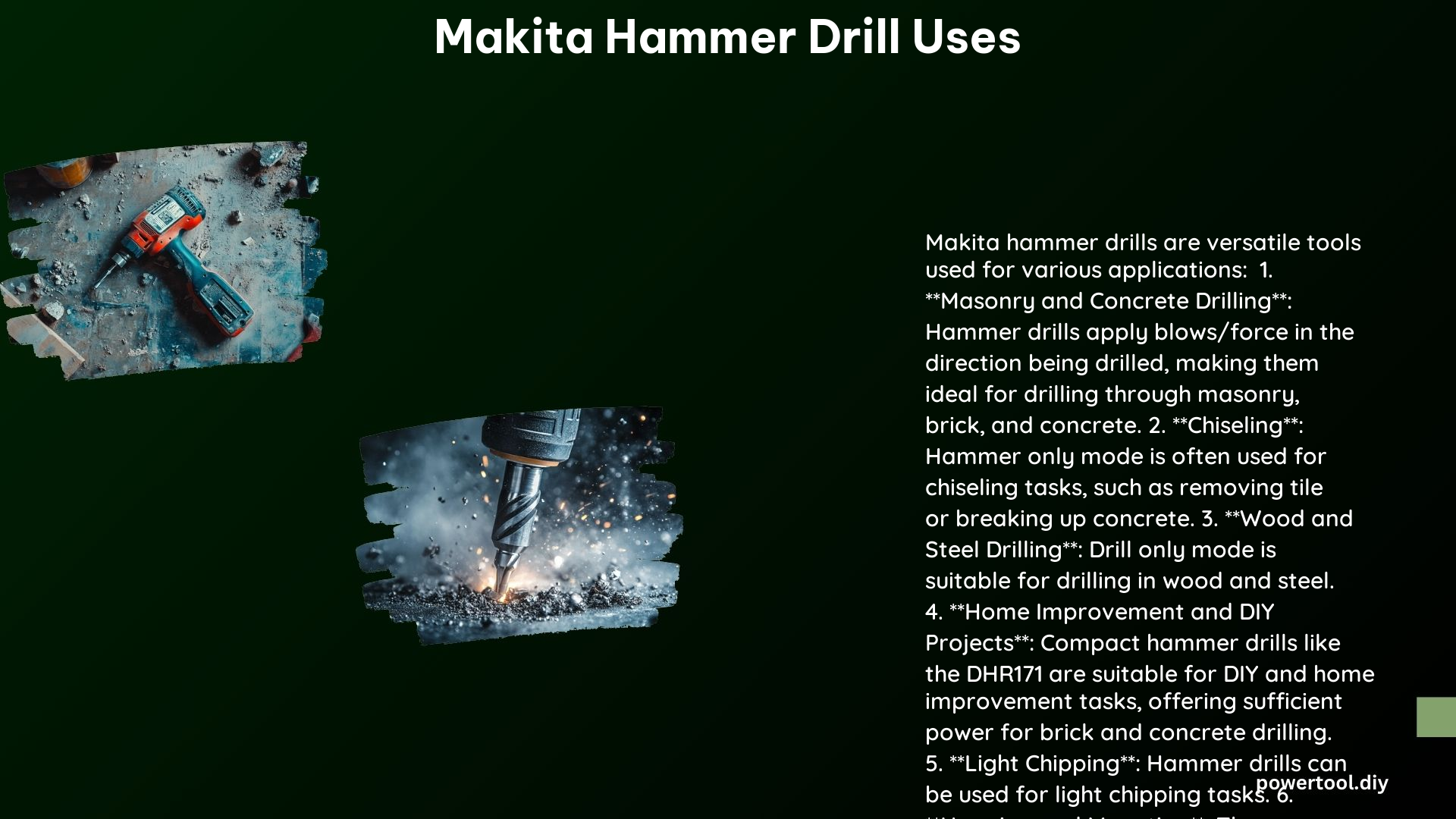The Makita hammer drill is a versatile power tool designed to tackle a wide range of drilling and hammering tasks, making it an essential addition to any DIY enthusiast’s or professional contractor’s toolkit. With its impressive power, compact design, and advanced features, the Makita hammer drill offers unparalleled performance and efficiency in a variety of applications.
Drilling in Masonry and Concrete
One of the primary uses of the Makita hammer drill is for drilling into masonry and concrete surfaces. The hammer mechanism applies a powerful percussive force, which helps the drill bit penetrate these hard materials with ease. This makes the Makita hammer drill an indispensable tool for tasks such as:
- Installing anchors, expansion bolts, and other fasteners in concrete walls or floors
- Drilling holes for electrical conduits, plumbing pipes, or other building services in masonry structures
- Creating openings for door frames, window installations, or other construction projects in brick, block, or stone
- Performing light demolition work, such as chipping away at concrete or removing old mortar
The Makita hammer drill’s impressive power output, ranging from 0 to 27,000 blows per minute (BPM), ensures efficient and effective drilling in even the toughest masonry materials. Additionally, the variable speed settings allow for precise control, enabling users to adjust the drill’s performance to match the specific requirements of the task at hand.
Drilling in Wood and Steel

While the Makita hammer drill is primarily designed for masonry and concrete applications, it can also be used for drilling into wood and steel. This versatility makes it a valuable tool for a wide range of DIY and home improvement projects, including:
- Drilling holes for screws, bolts, or other fasteners in wooden structures, such as framing, cabinetry, or furniture
- Creating openings for pipes, wires, or other building services in wooden walls or floors
- Drilling through steel plates, brackets, or other metal components for various construction or repair tasks
The Makita hammer drill’s high-torque motor and variable speed settings allow for precise control when drilling into these materials, ensuring clean, accurate holes without the risk of binding or damage to the workpiece.
Chiseling and Demolition
In addition to its drilling capabilities, the Makita hammer drill can also be used for light chiseling and demolition tasks. By attaching a chisel bit or other appropriate accessory, users can leverage the tool’s powerful hammering action to:
- Remove old mortar or grout from between bricks, tiles, or other masonry surfaces
- Break up small sections of concrete or other hard materials for repair or renovation work
- Perform light demolition tasks, such as removing old flooring or wall panels
The Makita hammer drill’s versatile design allows users to switch between drilling and chiseling modes, making it a valuable multi-purpose tool for a variety of construction and renovation projects.
Driving Screws
While the Makita hammer drill is primarily designed for drilling and hammering tasks, it can also be used for driving screws. By switching the tool to the appropriate mode, users can take advantage of the drill’s variable speed and torque settings to:
- Drive screws into wood, metal, or other materials with precision and control
- Prevent over-tightening or stripping of screws by adjusting the torque settings
- Efficiently install a wide range of fasteners, including wood screws, drywall screws, and machine screws
This versatility allows the Makita hammer drill to serve as a comprehensive power tool for both drilling and fastening applications, streamlining the workflow and reducing the need for multiple specialized tools.
Technical Specifications
The Makita hammer drill is available in a range of models, each with its own unique set of technical specifications. Here are some of the key features and specifications of the Makita hammer drill:
| Specification | Value |
|---|---|
| Battery | 18V LXT Lithium-Ion |
| Battery Capacity | 5.0Ah |
| Blows Per Minute (BPM) | 0 – 8,250 / 0 – 27,000 |
| No Load Speed (RPM) | 0 – 550 / 0 – 1,800 |
| Maximum Torque | 970 in.lbs. / 110N•m |
| Weight (with 5.0Ah battery) | 4.9 lbs. |
| Height | 6-7/8″ |
These specifications highlight the Makita hammer drill’s impressive power, efficiency, and portability, making it a versatile tool for a wide range of applications.
Makita Hammer Drill Models
Makita offers a variety of hammer drill models to suit different user needs and preferences. Some of the popular Makita hammer drill models include:
- XPH16T: 18V LXT Compact Brushless 1/2″ Hammer Driver-Drill Kit
- Compact and lightweight design
- Brushless motor for increased power and efficiency
-
Quick-change chuck for easy bit changes
-
DHR171: Sub-compact hammer drill for DIY and home improvement jobs
- Smaller and more maneuverable than full-size models
- Ideal for tight spaces and overhead work
-
Suitable for light to medium-duty drilling and hammering tasks
-
DHR243: More powerful hammer drill with quick-change chuck
- Increased power output for heavy-duty applications
- Quick-change chuck for fast and easy bit changes
-
Ideal for professional-grade construction and renovation projects
-
DHR183: Brushless hammer drill with AVT (Anti-Vibration Technology)
- Brushless motor for improved power and runtime
- AVT technology reduces vibration for increased user comfort
- Suitable for a wide range of drilling and hammering tasks
By offering a variety of models, Makita ensures that users can find the perfect hammer drill to meet their specific needs and preferences, whether they are DIY enthusiasts, professional contractors, or anyone in between.
